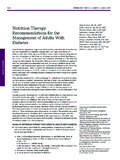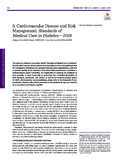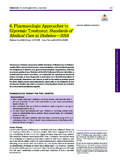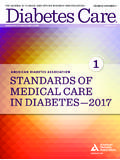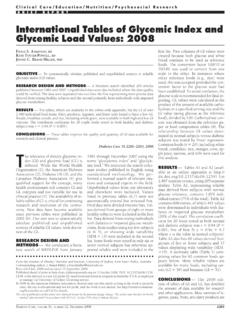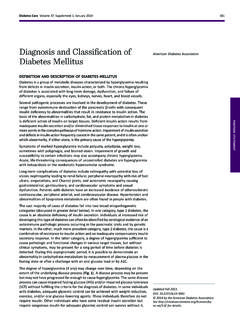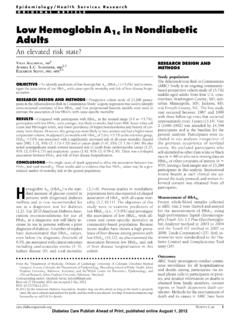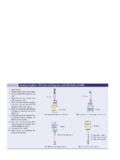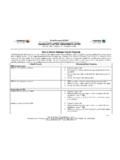Transcription of Insulin Administration - Diabetes Care
1 P O S I T I O N S T A T E M E N T. Insulin Administration AMERICAN Diabetes ASSOCIATION. I. nsulin is necessary for normal carbohy- opment. Regular is a short-acting Insulin . under the supervision of a health profes- drate, protein, and fat metabolism. Intermediate-acting insulins include lente sional with expertise in Diabetes . Human People with type 1 Diabetes mellitus do and NPH. Ultralente and Insulin glargine Insulin manufactured using recombinant not produce enough of this hormone to are long-acting insulins. Insulin prepara- DNA technology is replacing Insulin iso- sustain life and therefore depend on ex- tions with a predetermined proportion of lated from pigs. Future availability of an- ogenous Insulin for survival. In contrast, intermediate-acting Insulin mixed with imal Insulin is uncertain. individuals with type 2 Diabetes are not short- or rapid-acting Insulin ( , 70% Pharmacists and health care provid- dependent on exogenous Insulin for sur- NPH/30% regular, 50% NPH/50% regu- ers should not interchange Insulin species vival.)
2 However, over time, many of these lar, and 75% NPL/25% Insulin lispro) are or types without the approval of the pre- individuals will show decreased Insulin available. scribing physician and without informing production, therefore requiring supple- Different companies have adopted the patient of the type of Insulin change mental Insulin for adequate blood glucose different names for the same short-, inter- being made. If an individual is admitted control, especially during times of stress mediate-, or long-acting types of Insulin to a hospital, the type of Insulin he or she or illness. or their mixture. Human insulins have a has been using should not be changed in- An Insulin regimen is often required more rapid onset and shorter duration of advertently. If there is doubt about the in the treatment of gestational Diabetes activity than pork insulins. principal species, human Insulin should and Diabetes associated with certain con- Insulin is commercially available in be administered until adequate informa- ditions or syndromes ( , pancreatic dis- concentrations of 100 or 500 units/ml tion is available.
3 When purchasing Insulin , eases, drug- or chemical-induced Diabetes , (designated U-100 and U-500, respec- the patient should make sure that the type endocrinopathies, Insulin -receptor disor- tively; 1 unit equals 36 g of Insulin ). and species are correct and that the insu- ders, certain genetic syndromes). In all in- U-500 is only used in rare cases of Insulin lin will be used before the expiration date. stances of Insulin use, the Insulin dosage resistance when the patient requires ex- In the event that a patient's specific must be individualized and balanced with tremely large doses. U-500, Insulin lispro, brand of Insulin is temporarily unavail- medical nutrition therapy and exercise. Insulin aspart, Insulin glargine, and 75% able, the same Insulin formulation from This position statement addresses is- NPL/25% Insulin lispro require a pre- another manufacturer may be substi- sues regarding the use of conventional in- scription. Insulin preparations are some- tuted. Changing Insulin types ( , long, sulin Administration ( , via syringe or times formulated individually for use in intermediate, short, and rapid acting).
4 Pen with needle and cartridge) in the self- infants ( , U-10) with diluents pro- from one formulation to another should care of the individual with Diabetes . It vided by the manufacturer. In these in- always be done under medical supervi- does not address the use of Insulin pumps. stances, special care must be taken to sion. The patient should be fully informed (See the American Diabetes Association's ensure that the correct dose of the diluted as to the reason for any change in Insulin position statement Continuous Subcuta- Insulin is administered with an ordinary and the potential need for additional glu- neous Insulin Infusion for further dis- Insulin syringe. cose monitoring. cussion on this subject.) Different types and species of Insulin have different pharmacological proper- Insulin Insulin is obtained from ties. Human Insulin is preferred for use in Storage pork pancreas or is made chemically iden- pregnant women, women considering Vials of Insulin not in use should be re- tical to human Insulin by recombinant pregnancy, individuals with allergies or frigerated.
5 Extreme temperatures ( 36 or DNA technology or chemical modifica- immune resistance to animal-derived in- 86 F, 2 or 30 C) and excess agita- tion of pork Insulin . Insulin analogs have sulins, those initiating Insulin therapy, tion should be avoided to prevent loss of been developed by modifying the amino and those expected to use Insulin only potency, clumping, frosting, or precipita- acid sequence of the Insulin molecule. intermittently. Insulin type and species, tion. Specific storage guidelines provided Insulin is available in rapid-, short-, injection technique, Insulin antibodies, by the manufacturer should be followed. intermediate-, and long-acting types that site of injection, and individual patient re- Insulin in use may be kept at room tem- may be injected separately or mixed in the sponse differences can all affect the onset, perature to limit local irritation at the in- same syringe. Rapid-acting Insulin ana- degree, and duration of Insulin activity. jection site, which may occur when cold logs ( Insulin lispro and Insulin aspart) are Changing Insulin species may affect blood Insulin is used.
6 Available, and other analogs are in devel- glucose control and should only be done The patient should always have avail- able a spare bottle of each type of Insulin Originally approved 1989. Most recent review/revision, 2002. used. Although an expiration date is Abbreviations: SMBG, self-monitoring of blood glucose. stamped on each vial of Insulin , a loss in 2004 by the American Diabetes Association. potency may occur after the bottle has S106 Diabetes care , VOLUME 27, SUPPLEMENT 1, JANUARY 2004. Insulin Administration been in use for 1 month, especially if it Patients who are well controlled on a incorporate features designed to reduce was stored at room temperature. particular mixed- Insulin regimen should injury. Use of some currently available The person administering Insulin maintain their standard procedure for Insulin syringes with engineered sharps should inspect the bottle before each use preparing their Insulin doses. injury protection (ESIP) may present bar- for changes ( , clumping, frosting, pre- No other medication or diluent should riers to effective Insulin self-administra- cipitation, or change in clarity or color) be mixed with any Insulin product un- tion training.
7 Use of a device for training that may signify a loss in potency. Visual less approved by the prescribing physi- that is different from the device to be used examination should reveal rapid- and cian. in practice is inconsistent with teaching/. short-acting insulins as well as Insulin Insulin glargine should not be mixed learning principles, and may compromise glargine to be clear and all other Insulin with other forms of Insulin due to the the success of the training process. Indi- types to be uniformly cloudy. The person low pH of its diluent. vidualized patient assessment should with Diabetes should always try to relate Use of commercially available pre- guide the use of an ESIP Insulin syringe any unexplained increase in blood glu- mixed insulins may be used if the insu- during Insulin self- Administration in- cose to possible reductions in Insulin po- lin ratio is appropriate to the patient's struction. (See AADE, Diabetes Educ 28: tency. If uncertain about the potency of a Insulin requirements.)
8 730, 2000). vial of Insulin , the individual should re- Currently available NPH and short- Syringes must never be shared with place the vial in question with another of acting Insulin formulations when another person because of the risk of ac- the same type. mixed may be used immediately or quiring a blood-borne viral infection stored for future use. ( , acquired immune deficiency syn- Rapid-acting Insulin can be mixed with drome or hepatitis). Mixing Insulin NPH, lente, and ultralente. Travelers should be aware that Insulin Administration of mixtures of rapid- or When rapid-acting Insulin is mixed is available in a strength of U-40 outside short- and intermediate- or long-acting with either an intermediate- or long- of the To avoid dosing errors, sy- insulins will produce a more normal gly- acting Insulin , the mixture should be ringes that match the concentration of cemia in some patients than use of a single injected within 15 min before a meal. U-40 Insulin must be used. Insulin .
9 The formulations and particle size Mixing of short-acting and lente insu- distributions of Insulin products vary. On Disposal lins is not recommended except for pa- mixing, physicochemical changes in the Recapping, bending, or breaking a needle tients already adequately controlled on mixture may occur (either immediately or increases the risk of needle-stick injury such a mixture. If short-acting and lente over time). As a result, the physiological and should be avoided. Insulin syringes mixtures are to be used, the patient response to the Insulin mixture may differ and pens, needles, and lancets should be should standardize the interval be- from that of the injection of the insulins disposed of according to local regulations. tween mixing and injection. separately. When rapid-acting and ultra- . Some areas may have special needle dis- Phosphate-buffered insulins ( , lente insulins are mixed, there is no blunt- posal programs to prevent sharps from NPH) should not be mixed with lente ing of the onset of action of the rapid- being in the main waste disposal stream.
10 Insulins. acting Insulin . A slight decrease in the . When community disposal programs are Insulin formulations may change;. absorption rate, but not the total bioavail- unavailable, used sharps should be placed therefore, the manufacturer should be ability, is seen when rapid-acting and pro- in a puncture-resistant container. Local consulted in cases where its recommen- tamine-stabilized Insulin (NPH) are trash authorities should be contacted for dations appear to conflict with the mixed. In clinical trials, however, the proper disposal of filled containers. care American Diabetes Association guidelines. postprandial blood glucose response was should be taken to keep these filled con- tainers away from containers to be recy- similar when rapid-acting Insulin was SYRINGES Conventional Insulin mixed with either NPH or ultralente. Mix- cled. In areas with container-recycling Administration involves subcutaneous in- ing of short-acting and lente insulins is programs, placement of containers of jection with syringes marked in Insulin not recommended, except for patients al- used syringes, needles, and lancets with units.

